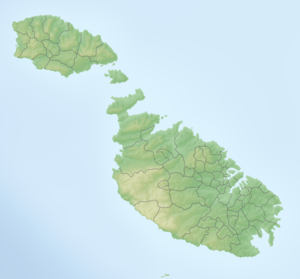Santa Marija Battery
| Santa Marija Battery | ||
|---|---|---|
| Alternative name (s): | Batterija ta 'Santa Marija | |
| Creation time : | 1715/16 | |
| Conservation status: | restored (1996–1997) | |
| Construction: | Limestone - masonry | |
| Place: | Comino | |
| Geographical location | 36 ° 0 '24 " N , 14 ° 20' 46.5" E | |
|
|
||
The Santa Marija Battery is a fortification built on the Maltese island of Comino during the rule of the Order of St. John from 1715 to 1716 .
prehistory
The Johanniter had surrounded the coasts of Malta , Gozo and Comino in the 17th century with a network of watchtowers in order to be able to detect the approach of enemy ships in time. At the beginning of the 18th century the concept of defense changed. They wanted to be able to fight the enemy already at sea or during the landing. The lightly armed towers were not sufficient for this. Therefore, the defense network was expanded to include a number of coastal batteries and redoubts that could actively fight enemy fleets with their cannons and fire at endangered coastal areas. The building plans were drawn up in 1714 by Jacques de Camus d'Arginy, Bernard de Fontet and François Bachelieu. An influential advocate of the project was the French Grand Prior of the Order, Philippe de Vendôme , who personally donated 40,000 Scudi .
To monitor the Gozokanals already served St Mary's Tower in the south west of Comino, Ahrax Tower and St Agatha's Tower in Malta and the Mġarr ix-Xini Tower in Gozo. From 1715 to 1716 these were supplemented by the Wied Musa Battery on Malta and - opposite this - the Santa Marija Battery on Comino. The cost of the latter was 1018 scudi.
description
The battery, made of limestone masonry, consists of a semicircular platform facing the lake for the cannons as well as residential and warehouse buildings in the rear. On the land side, the position is completely protected by a wall or the walls of the buildings. The largest log house is aligned so that two of its side walls form a redan, a kind of triangular bastion . This gave the defenders the opportunity, side the space immediately in front of the wall, which they could not see straight from loopholes with muskets to spread . The platform has a parapet with eight loopholes, but was manned with only six cannons, two 24-pounders and four 6-pounders.
The battery has not been used for long. It was unoccupied as early as 1770. Before the Second World War it was inhabited by a Gozitan family. After the war it was abandoned and fell into disrepair.
restoration
The non-profit organization Dín l-Art Ħelwa carried out a restoration of the Santa Marija Battery in 1996/97. The facility was cleaned, the entrance, which was about to collapse, was repaired and the heavily eroded stones of the loopholes were replaced. The rooms were laid out with stone slabs and the roofs put in order. The main entrance was given an iron gate and the loopholes were secured with wire grids. In 1997 four cannons were set up again. The battery has been freely accessible to visitors ever since.
Since 1995 the Mistra Battery has been on the list of cultural properties of Malta ( National Inventory of the Cultural Property of the Maltese Islands ) under number 00042 .
Individual evidence
- ↑ Stephen C. Spiteri : 18th Century Hospitaller Coastal Batteries ( Memento from December 12, 2015 in the Internet Archive ), 2010 (English)
- ↑ a b c Steve Borg: The 1715 Santa Marija Battery (English)
- ↑ St. Mary Battery (PDF; 304 kB) in the National Inventory of the Cultural Property of the Maltese Islands of March 30, 2012 (English), accessed on March 3, 2019.
Web links
- Santa Marija Battery, Comino on the website of Dín l-Art Ħelwa (English)
- Victor Rizzo: Our Heritage saved… Santa Marija Tower and Battery in Comino . In: Malta Independent , February 25, 2007 (English)
- St. Mary's Gun Battery (aka Trunciera) on the Comino Ferries Co-Op Ltd. homepage (English)




